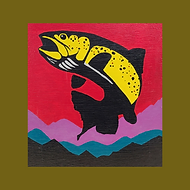**Introduction:**
Winter tailwater fishing offers a unique and rewarding challenge for anglers willing to brave the chill. As the temperatures drop and snow blankets the landscape, tailwaters provide a haven for dedicated fishermen seeking solitude and the chance to land some impressive catches. In this blog post, we’ll delve into the world of winter tailwater fishing, exploring the tactics, gear, and strategies that can make your cold-weather angling experience not only enjoyable but also successful.
**Understanding Winter Tailwaters:**
Tailwaters, the outflows from dams, maintain more stable water temperatures compared to freestone rivers, creating an environment where fish can thrive even in the coldest months. The regulated water flow and consistent temperatures make tailwaters prime locations for winter fishing.
**Targeting Winter Species:**
While various fish species can be found in tailwaters, trout, including brown and rainbow trout, are often the primary focus for winter anglers. These fish are known for their resilience in cold water and can provide exciting opportunities even in the most frigid conditions.
**Tactics and Techniques:**
1. **Nymphing:** In winter, fish are generally less active, making nymphing a go-to technique. Use small, natural-colored nymphs such as midge patterns and zebra midges. Fish them deep and slow, as trout tend to hold in slower-moving water during colder months.
2. **Streamers:** Entice aggressive strikes with streamers. Choose patterns that imitate small baitfish or sculpins, and fish them with a slow, enticing retrieve. Pay attention to the depth at which the fish are holding.
3. **Dry Fly Fishing:** While less common in winter, there are instances of midge hatches that can bring fish to the surface. Keep an eye out for rising fish and be ready with small, sparse dry fly patterns.
**Essential Gear for Winter Tailwater Fishing:**
1. **Insulated Waders and Layers:** Stay warm and dry with insulated waders. Layer up with moisture-wicking base layers, insulating mid-layers, and a waterproof, windproof outer layer.
2. **Quality Fly Rod and Reel:** Choose a rod with enough backbone to handle larger fish, as winter often brings larger trout into tailwaters. Pair it with a reliable reel and quality fly line suitable for cold conditions.
3. **Fly Selection:** Carry a variety of midge patterns, small nymphs, and streamers. Be prepared to experiment with different colors and sizes to match the hatch or entice bites.
**Safety Considerations:**
1. **Check Ice Conditions:** If fishing on a tailwater with sections prone to freezing, be cautious of ice. Ensure it’s safe before venturing onto frozen surfaces.
2. **Dress Appropriately:** Protect yourself from the cold with appropriate clothing, including insulated gloves, a warm hat, and layered clothing.
**Conclusion:**
Winter tailwater fishing presents a unique set of challenges, but for those willing to embrace the cold, the rewards can be substantial. As you venture into the serene landscapes surrounding these regulated flows, armed with the right tactics and gear, you’ll discover a winter wonderland teeming with opportunities for memorable angling experiences. So, gear up, embrace the chill, and unlock the secrets of winter tailwater fishing. Your next big catch might be just a cast away.


